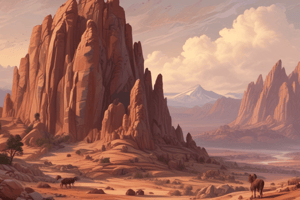Podcast
Questions and Answers
What is the term used for the larger crystals found in igneous rocks?
What is the term used for the larger crystals found in igneous rocks?
- Glassy texture
- Groundmass
- Phenocryst (correct)
- Matrix
Which type of igneous rock is characterized by a high percentage of quartz and a light color?
Which type of igneous rock is characterized by a high percentage of quartz and a light color?
- Intermediate
- Felsic (correct)
- Ultramafic
- Mafic
Which term describes noncrystalline rocks that contain no mineral grains?
Which term describes noncrystalline rocks that contain no mineral grains?
- Vitreous
- Porphyritic
- Vesicular texture
- Glassy texture (correct)
What causes vesicular texture in igneous rocks?
What causes vesicular texture in igneous rocks?
What mineral accounts for up to 60% of the composition of granite?
What mineral accounts for up to 60% of the composition of granite?
What is the primary factor that influences the size of mineral crystals in igneous rocks?
What is the primary factor that influences the size of mineral crystals in igneous rocks?
Which characteristic distinguishes extrusive igneous rocks from intrusive igneous rocks?
Which characteristic distinguishes extrusive igneous rocks from intrusive igneous rocks?
What type of texture do rocks like granite exhibit?
What type of texture do rocks like granite exhibit?
Which of the following rocks would be classified as having a fine-grained or aphanitic texture?
Which of the following rocks would be classified as having a fine-grained or aphanitic texture?
Which of the following statements about the cooling of magma is incorrect?
Which of the following statements about the cooling of magma is incorrect?
What kind of igneous rock forms when magma cools and solidifies beneath the Earth's surface?
What kind of igneous rock forms when magma cools and solidifies beneath the Earth's surface?
Which term describes rocks with a significant difference in grain size?
Which term describes rocks with a significant difference in grain size?
What does the term 'crystallization' refer to in the context of igneous rocks?
What does the term 'crystallization' refer to in the context of igneous rocks?
What process primarily leads to the formation of evaporites?
What process primarily leads to the formation of evaporites?
Which type of metamorphism is primarily driven by heat and reactive fluids?
Which type of metamorphism is primarily driven by heat and reactive fluids?
What characterizes bioclastic rocks?
What characterizes bioclastic rocks?
What is a common result of regional metamorphism?
What is a common result of regional metamorphism?
Which rock type is NOT typically formed through the process of metamorphism?
Which rock type is NOT typically formed through the process of metamorphism?
What is the primary effect of compaction on sediment grains?
What is the primary effect of compaction on sediment grains?
What characterizes graded bedding in sedimentary rocks?
What characterizes graded bedding in sedimentary rocks?
Which sedimentary feature is created by drying wet sediment?
Which sedimentary feature is created by drying wet sediment?
What does the term 'mafic' refer to in geology?
What does the term 'mafic' refer to in geology?
What type of sedimentary rock is primarily formed through evaporation?
What type of sedimentary rock is primarily formed through evaporation?
What is indicated by the presence of fossils in sedimentary rocks?
What is indicated by the presence of fossils in sedimentary rocks?
Which minerals are typically associated with ultramafic rocks?
Which minerals are typically associated with ultramafic rocks?
In Bowen's Reaction Series, what is primarily observed in the discontinuous reaction series?
In Bowen's Reaction Series, what is primarily observed in the discontinuous reaction series?
How are clastic sedimentary rocks primarily classified?
How are clastic sedimentary rocks primarily classified?
What is the first step in the formation of sedimentary rocks?
What is the first step in the formation of sedimentary rocks?
Which of the following is NOT classified as a non-clastic sedimentary rock?
Which of the following is NOT classified as a non-clastic sedimentary rock?
What characterizes the continuous reaction series in Bowen’s Reaction Series?
What characterizes the continuous reaction series in Bowen’s Reaction Series?
What type of sedimentary structure involves beds inclined relative to one another due to current movement?
What type of sedimentary structure involves beds inclined relative to one another due to current movement?
During lithification, which process initially occurs to sediment?
During lithification, which process initially occurs to sediment?
Which step in the sedimentary processes involves the movement of weathered products?
Which step in the sedimentary processes involves the movement of weathered products?
Which type of rock is identified as andesitic or intermediate?
Which type of rock is identified as andesitic or intermediate?
Flashcards are hidden until you start studying
Study Notes
ROCKS AND MINERALS
- Rocks are natural, solid, nonliving materials composed of one or more minerals.
- Minerals are the building blocks of rocks.
TYPES OF ROCKS
- Rocks are classified into three major types: igneous, sedimentary, and metamorphic.
IGNEOUS ROCK
- Derived from the Latin word for "fire."
- Formed from the cooling and solidification of magma.
- Crystal size depends on cooling time: slow cooling produces large crystals, rapid cooling creates small crystals.
Main Categories
-
Extrusive Igneous Rocks (Volcanic)
- Form on the Earth's surface from lava.
- Generally have small crystals due to rapid cooling, known as aphanitic texture.
-
Intrusive Igneous Rocks (Plutonic)
- Form below the Earth's surface from magma that cools slowly.
- Characterized by large, visible crystals, known as phaneritic texture.
TEXTURE OF IGNEOUS ROCKS
-
Coarse Grained (Phaneritic)
- Large, visible crystals; examples include granite, gabbro, and diorite.
-
Fine-Grained (Aphanitic)
- Small, invisible crystals; example includes basalt.
-
Porphyritic Texture
- Contains two different crystal sizes, with phenocrysts (larger) in a finer groundmass.
-
Glassy Texture (Vitreous)
- Non-crystalline rocks with no mineral grains, such as obsidian.
-
Vesicular Texture
- Formed by gas bubbles from rising magma, resulting in a porous appearance.
CHEMICAL COMPOSITION OF IGNEOUS ROCKS
-
Felsic Rocks
- Light-colored, high in feldspar and quartz.
-
Mafic Rocks
- Dark-colored, rich in magnesium and iron; example includes basalt.
-
Andesitic (Intermediate) Rocks
- Contain a mix of light and dark minerals like amphibole and plagioclase feldspar.
-
Ultramafic Rocks
- Composed mainly of dark minerals such as olivine.
BOWEN’S REACTION SERIES
- Describes the crystallization process of magma.
- Discontinuous Series: Minerals crystallize in steps (e.g., olivine, pyroxene).
- Continuous Series: Plagioclase minerals range from calcium-rich at high temperatures to sodium-rich at low temperatures.
SEDIMENTARY ROCKS
- Formed from the accumulation of sediments or pre-existing rocks.
- Commonly develop at or near the Earth's surface through sedimentary processes.
SEDIMENTARY PROCESSES
- Weathering: Breakdown of rocks into smaller fragments.
- Erosion: Movement of weathered materials.
- Transportation: Sediment movement via wind, water, or gravity.
- Deposition: Occurs when energy decreases, allowing sediments to settle.
- Lithification: Converts sediment into rock, primarily through compaction.
COMMON SEDIMENTARY FEATURES
- Stratification and Bedding: Layers of sediment.
- Cross Bedding: Inclined layers formed by water or wind movement.
- Graded Bedding: Layering characterized by decreasing grain size.
- Ripple Marks: Formed by flowing water over sediments.
- Mudcracks: Result from drying sediments.
- Fossils: Indicators of past life and depositional environments.
TYPES OF SEDIMENTARY ROCKS
- Clastic: Composed of grains, classified by particle size (e.g., sandstone, shale, conglomerate).
- Non-Clastic: Formed by evaporation/precipitation of minerals or lithification of organic matter (e.g., limestone, coal).
METAMORPHIC ROCKS
- Formed from existing rocks due to pressure and temperature changes during metamorphism.
Types of Metamorphism
-
Contact Metamorphism
- Involves heat and reactive fluids from nearby magma, creating non-foliated rocks.
-
Regional Metamorphism
- Occurs under high pressure and extensive deformation, typically during mountain-building events.
Studying That Suits You
Use AI to generate personalized quizzes and flashcards to suit your learning preferences.




